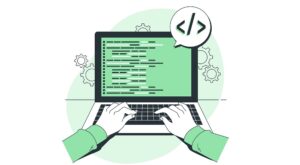What is IDE? Introduction to its use in programming
Imagine that you want to enter the world of programming, but before you do, you need a magical toolbox to provide you with everything. This is where IDE (Integrated Development Environment) comes into play, like a guide who will accompany you on this exciting journey! IDE is not just software but a whole world of features and capabilities that allow you to write your code faster, identify bugs quickly, and turn your creative ideas into reality.
Everything is included in this unique toolbox, from the code editor that lets you write your code beautifully to the debugging tools that find the most minor errors in the blink of an eye. In this blog, we invite you to the wonderful world of IDEs, where you will get to know the different types of IDEs and see how these tools can turn your coding experience into an enjoyable and unique adventure. Are you ready to delve into the heart of programming and discover the secrets of IDEs? Let’s get started.
What is an IDE?
An IDE, “Integrated Development Environment,” is an essential tool for programmers in the software development process. An IDE is designed to simplify and optimize the coding process and usually includes different tools and features. Object-oriented programming can be much easier with the help of an IDE. Below, we will examine the various aspects of an IDE:
What is an IDE code editor?
This is the central part of the IDE that allows programmers to write code. A code editor usually includes features such as:
Syntax highlighting: This makes the code structure more transparent.
Auto-completion: this helps users code faster and avoid common mistakes.
Search and replace: to quickly find and fix code.
What is an IDE compiler and interpreter?
An IDE usually includes a compiler or interpreter for different programming languages . This tool converts written code into machine language and allows the code to be executed directly.
What is an IDE debugger?
A debugger is a tool that helps programmers identify and fix bugs. Using a debugger, debugging can be done much more quickly
Execute code line by line.
Set breakpoints.
Monitor variables and their states at runtime.
Project Management in IDEs
IDEs allow you to organize and manage your project files and resources in an organized manner. These include:
A tree structure of files and folders.
The ability to add or remove project files and resources.
Integration with other tools
IDEs often integrate with external tools, including:
Version control systems (such as Git) to manage code changes.
Build tools (such as Maven or Gradle) to simplify dependency management and the build process.
Code review tools in IDEs
Some IDEs have tools for checking code quality and identifying weaknesses, including linting and automatic formatting, to help improve code quality. If you want to become a successful programmer, we recommend using an IDE.
Libraries and Frameworks in IDE
IDEs are usually available in various libraries and frameworks that help speed development.

History of IDEs
The history of integrated development environments (IDEs) dates back to the early 1970s. Here is a historical overview and essential developments in the development of IDEs:
Early Years (1970s)
During this period, programmers mainly wrote code using simple text editors and command lines. Some of the first development tools included programming languages and simple editors. For example, TEXT Editor and FORTRAN were very popular at this time.
1980s
As software became more complex, the need for more powerful tools became apparent. Early IDEs such as Turbo Pascal and Microsoft QuickBasic introduced a code editor, compiler, and debugger, making programming more straightforward for users.
1990s
At this time, the presence of more advanced IDEs such as Visual Studio (focused on C++ and later C programming languages) and Borland Delphi is seen. These IDEs offered new features such as graphic design and project management tools.
2000s
The emergence of new languages and the need for development environments for web programming led to the emergence of IDEs such as Eclipse (for Java languages) and NetBeans. These IDEs attracted a large community of developers with their modular design and excellent customization capabilities.
2010s to present
With new concepts such as open-source software development, online collaboration, and mobile application development, IDEs such as Visual Studio Code and JetBrains IntelliJ IDEA gained popularity. These IDEs also came equipped with code auto-completion, version control system integration, and advanced debugging tools.
New Trends
Today, with the need for cross-platform programming and web-based entertainment, new tools have emerged, such as Jupyter Notebook for data science and machine learning and GitHub Codespaces for online development. There is also an increasing focus on using artificial intelligence to facilitate code writing. The history of IDEs shows the evolution and advancement in programming and software development, gradually making the tools more user-friendly and powerful for programmers.
Why are IDEs important?
This tool is essential for programmers, and the following reasons can be mentioned for its importance:
Organization
IDEs allow you to write and manage code in a structured and organized environment.
Facilitates the coding process
The coding process becomes much easier and faster with features such as auto-completion, advanced editors, and live errors.
Easy Debugging
IDEs have powerful debugging tools that help you quickly identify and fix code errors.
Project Management
These environments allow you to manage and organize large and complex projects, including managing dependencies and versions.
Integration with other tools
Many IDEs integrate with other tools, such as version control systems (such as Git) and databases, which increases efficiency.
Support for different languages
Most IDEs support multiple programming languages, meaning you can efficiently work on different projects. Using an IDE can increase productivity and code quality and facilitate software development.
IDE Applications with Examples
IDEs (Integrated Development Environments) are used in various programming and software development fields. Here are some of these applications with examples:
Web development: For example, Visual Studio Code and WebStorm help developers develop websites and web applications using HTML, CSS, and JavaScript programming languages. These IDEs have tools for editing code and debugging.
Desktop software development: Java software is developed using Eclipse and NetBeans. These IDEs allow developers to write and run Java code and benefit from debugging and project management tools.
Mobile application development: Android Studio is designed to develop Android applications. This IDE includes emulators that allow you to test your applications on different devices.
Data Science and Machine Learning Development: Jupyter Notebook allows data scientists and researchers to write Python code interactively and see the results immediately. This tool is especially popular for data analysis and machine learning projects.
Game Development: The Unity and Unreal Engine game engines are powerful IDEs for video game development. These tools combine graphics and programming, allowing game developers to create more advanced gaming experiences.
Application Development and Automation: For example, Microsoft Visual Studio is used for developing Windows applications and programming in languages such as C and VB.NET. This IDE helps developers code faster and more efficiently.
These examples show the diversity and breadth of IDE use in different areas of software development. Each IDE has specific tools that help make the programmer’s work easier.

What are the features of IDEs?
Integrated Development Environments (IDEs) provide tools and features that help programmers write code faster and more efficiently. The following are the main features of an IDE explained in detail:
Code Editor
The basic editor enables programming and includes features such as syntax highlighting to facilitate code readability and auto-completion to speed up code writing and code speech.
Compiler and Interpreter
IDEs usually include compilers and interpreters for different programming languages, which allow programmers to compile or run their code directly from within the IDE environment.
Debugger
A debugger is a tool that helps programmers find and fix errors in code. These tools typically include breakpoints, variable monitoring, and step-by-step code execution.
Project Management
IDEs help developers organize more significant projects. This includes managing files, project settings, and dependencies.
Version Control
Many IDEs include features that help integrate with version control systems (such as Git), which allows developers to track and manage changes to the code.
Testing Tools
IDEs may include tools for writing and running unit tests and integration tests, which help ensure code quality and increase productivity.
Database Management
Many IDEs allow developers who work with databases to connect to and manage databases.
Framework and library support
IDEs typically support popular frameworks and libraries, providing additional capabilities such as faster coding and ease of development.
Graphical design environment
Modern IDEs typically offer graphical design capabilities for user interface developers that allow users to easily add and adjust user interface elements in a visual environment.
Documentation system management
IDEs typically include facilities for generating documentation from existing code and access to documentation for different languages and frameworks, including the Python framework.
Multilingual support
Many IDEs support multiple programmers with different languages (such as Python, Java, C, and JavaScript), allowing them to work on multilingual code.
Plugins and Extensibility
IDEs usually allow the installation of custom plugins, which add additional capabilities to the development environment and can provide specific features according to the developer’s needs. These features generally help programmers write code more efficiently, increase the quality of developed software, and reduce development time.
What are the advantages and disadvantages of IDEs?
IDEs (integrated development environments) have advantages and disadvantages. Below, I will mention some of them:
What are the advantages of IDEs?
More efficient programming: IDEs include automation and code completion tools that help improve code writing speed.
Error monitoring: Most IDEs can identify errors and bugs in the code in real time, which helps developers find and fix errors faster.
Easier debugging: IDEs offer powerful tools for debugging code. These tools allow you to examine your program as it runs and identify problems.
Project management: IDEs help organize and manage projects so you can easily manage files and libraries.
Integration support: Many IDEs integrate with version control systems (such as Git), helping with team collaboration.
Support for various frameworks and libraries: IDEs usually support multiple tools and popular frameworks.
What are the disadvantages of IDEs?
Bulky and high resources: Some IDEs can be resource-intensive and require a lot of RAM and CPU.
Complexity: Complex IDEs can be difficult to learn and use for beginners and can take some time.
Reliance on tools: Overuse of automated features may impair a programmer’s ability to write code without the help of tools.
Reduced generation of optimal code: Sometimes, automation in code generation can lead to the production of unoptimal code.
Need for configuration: Some IDEs require initial configuration and setup, which may be time-consuming for some users. Ultimately, choosing an IDE or a text editor depends on your needs and preferences.

What are the known types of IDEs?
IDEs (Integrated Development Environments) are divided into different categories, each with features and capabilities. Here are some of the known types of IDEs:
General IDEs
Eclipse: Mostly for Java languages and multi-purpose software development.
NetBeans: Suitable for Java programming and other languages such as PHP.
Language-specific IDEs
PyCharm IDE: Specialized in the Python programming language.
RubyMine IDE: This is for software development using Ruby.
Web-specific IDEs
WebStorm IDE: Professional in web development, primarily JavaScript.
Visual Studio Code: A powerful text editor with great features for web development and various languages.
Mobile-specific IDEs
Android Studio IDE: Official for Android application development.
Xcode IDE: For developing iOS and macOS apps.
Proprietary IDEs
Visual Studio IDE: Comprehensive for developing software in multiple languages, especially C and . NET.
IntelliJ IDEA IDE: Powerful for Java with advanced features.
Open-source IDEs
Atom: A highly customizable open-source text editor and IDE.
VS Code: A source code editor with IDE features like plugin capabilities.
Choosing the proper IDE depends on the type of project and programming language you are working on. Each has its own advantages and disadvantages, which can be tailored to your needs.
Common Features of IDEs
Standard features of IDEs (integrated development environments) include:
Code editor Provides an environment for writing and editing code, with syntax highlighting and auto-completion capabilities.
Debugging: Tools for identifying and fixing bugs in code, including breakpoints and variable viewing.
Project management: The ability to organize project files and folders in a structured way.
Compiler/interpreter: Integration of compilation or interpreter tools to execute code.
Version control system: Features for managing changes to code using version control systems such as Git.
Plugin and extension support: The ability to add additional tools to improve the performance and features of the IDE.
Dependency management: Functions for installing and managing libraries and dependencies the project requires.
These features provide developers a convenient platform for quickly writing code, identifying bugs, and managing their projects.
What are the best IDEs?
The best IDE for coding depends on several factors, including the programming language you use, the type of project, and your personal experience. Below, I will mention some of the best IDEs based on different languages and needs:
IDE for Java
IntelliJ IDEA: Very powerful and has advanced features.
Eclipse: Open source and customizable.
IDE for Python
PyCharm: Has a variety of tools and strong integration with frameworks.
Visual Studio Code: The right plugins can become a powerful IDE.
IDE for C and C++
Visual Studio: Various features and firm support.
Code: Blocks: Open source and customizable for all C/C++ projects.
IDE for JavaScript and HTML/CSS
Visual Studio Code: A lightweight environment with many plugins.
Atom: Popular and customizable.
IDE for mobile development
Android Studio: The best choice for developing Android applications.
Xcode: For developing iOS and macOS applications.
IDE for the web
WebStorm: A powerful IDE for JavaScript and web development.
Sublime Text: Fast and lightweight, especially with the correct settings.
Choosing the best IDE depends on your needs and preferences. Try several IDEs and select the ones that are most useful to you.

Challenges of Using IDEs
Using IDEs (Integrated Development Environments) can come with challenges. These include:
Difficulty in learning: Some IDEs can be very complex, and learning all the tools and features can be time-consuming for beginners.
Compatibility issues: Some IDEs may not be compatible with specific versions of programming languages or libraries. This can cause problems with existing projects.
Speed and performance: Heavy IDEs can slow down the system and cause delays in loading or running projects.
Limited customization: Some IDEs may have limited customization options, which can be limiting for experienced and professional developers.
System resource requirements: Using bulky IDEs can require a lot of system resources (RAM and CPU), which can reduce performance on low-capacity systems.
Software bugs: Like any other software, IDEs can have bugs affecting user experience.
Tool dependency: Some developers may become dependent on the features included in the IDE, reducing their ability to code without it.
Plugin management: Using different plugins to add new features can cause compatibility issues.
Limited language support: Some IDEs may not support all programming languages well, which can be a problem for multilingual developers.
Cost: Some IDEs may be expensive or require a subscription to use advanced features, which can also pose user challenges. Despite these challenges, many developers use IDEs for software development because of their speed and efficiency.
Important points about IDEs
Here are some essential points about IDEs (Integrated Development Environments) that every programmer should be aware of:
IDE User-friendliness
IDEs usually have a graphical user interface (GUI) that makes them easier for programmers to work with. This GUI allows users to easily use various features and tools.
Powerful code editor
One of the main features of an IDE is the code editor, which supports writing capabilities such as auto-completion, syntax highlighting, and code formatting. These features help improve the speed and accuracy of coding.
Debugging tools
IDEs usually have powerful debugging tools that allow you to identify and fix errors. You can easily access the code’s functionality using breakpoints and line-by-line debugging.
Project Management
IDEs allow you to manage large projects most simply. You can organize files and folders and easily access various project resources.
Integration with other tools
Many IDEs easily integrate with tools like version control systems (such as Git), databases, and other development tools. This feature helps improve the efficiency and coordination of development teams.
Support for different languages
Many IDEs support different programming languages, so you can develop software in other languages using one tool.
Extensions and Plugins
Many IDEs support various extensions and plugins, which allow you to extend their functionality to your liking and add specific tools to your development environment.
Code Analysis
Some IDEs offer code analysis capabilities that help identify issues and improve code quality. This feature can help you write clean and efficient code.
Different Development Environments
Many IDEs allow you to create different development environments for various projects, allowing you to manage other settings and configurations for each project independently.
Training and Documentation
Many IDEs include excellent documentation and educational resources to help you learn programming and use the tool better. These tips can help you choose and use IDEs optimally and significantly improve your software development experience.
Components of an IDE
An IDE (Integrated Development Environment) usually comprises different components, each with its specific function. The main components of an IDE are:
Code editor: The part where programmers write their code. This editor usually includes syntax highlighting, auto-completion, and linting.
Compiler/interpreter: A tool for converting source code into machine-executable code. The compiler converts the code into machine language, and the interpreter directly executes the code.
Debugger: A tool for identifying and fixing errors in the code. This part allows you to set breakpoints, view variables, and step through the code.
Project management: Facilities for creating, editing, and managing project structures. This part helps developers manage their projects coherently.
Dependency Manager: A tool for installing and managing libraries and dependencies required by a project. This section includes features for quickly adding and updating dependencies.
Console or Terminal: A section that allows developers to enter commands and view the output of programs.
Testing Tools: Features for writing and running automated tests for code, which help developers improve code quality.
Version Control Tools: Tools for managing changes to code, such as merging and managing branches using systems like Git.
Plugins and Extensions are features that add new functionality to the IDE. These can include additional tools for coding, debugging, or building and managing projects. These components allow developers to make the software development process more efficient and straightforward.

Most Famous IDEs
There are many integrated development environments (IDEs) worldwide, each with its features and capabilities. Below are some of the most famous IDEs:
Visual Studio: This IDE from Microsoft is very popular, especially for developing Windows and web applications. It supports various languages , such as C and VB. NET, and C++.
IntelliJ IDEA: JetBrains developed this powerful and popular IDE for developing with Java. This IDE also supports writing codes in other languages , such as Kotlin and Scala.
Eclipse: An open-source IDE for developing in various languages, especially Java. Eclipse is full of plugins and additional features that can help developers.
PyCharm: This IDE from JetBrains is for developing with Python. PyCharm has powerful tools for debugging and testing.
Xcode: Apple’s IDE is used specifically for developing iOS and macOS applications and supports languages such as Swift and Objective-C.
NetBeans: Another open-source IDE mainly used for Java development but supports other languages such as PHP and HTML5.
Android Studio is an official IDE for developing Android applications. It is built on IntelliJ IDEA and has specific tools for building Android applications.
Visual Studio Code: Although this program is not a full IDE, it is a powerful and lightweight code editor that can easily be converted into an IDE with numerous plugins.
Rider: This IDE from JetBrains is explicitly designed for developing with C and . NET languages and provides advanced features for developers.
These IDEs are very popular among developers due to their capabilities and features. Each is designed for a specific type of software development.
Conclusion
In conclusion, IDE (Integrated Development Environment) is an essential tool for programmers and software developers. These environments make the software development process simpler and more efficient by providing features such as text editors, debugging tools, project management, and version control systems. Choosing the right IDE depends on your specific needs and programming languages and can significantly impact the quality and speed of your coding. By considering the set of tools and features of each IDE, you can choose the environment that best supports your work and helps you create better and more efficient software. Becoming familiar with different IDEs and their features can help you become a more skilled and efficient developer.